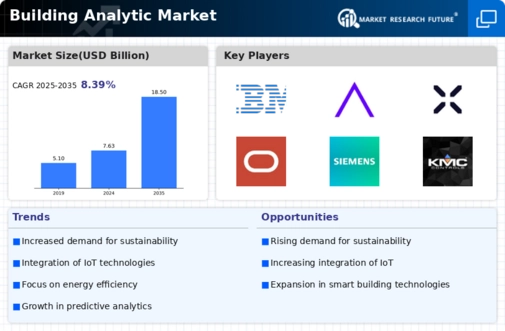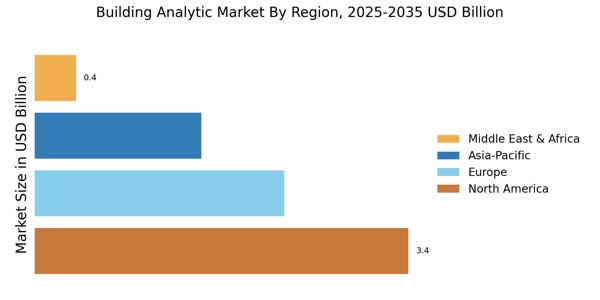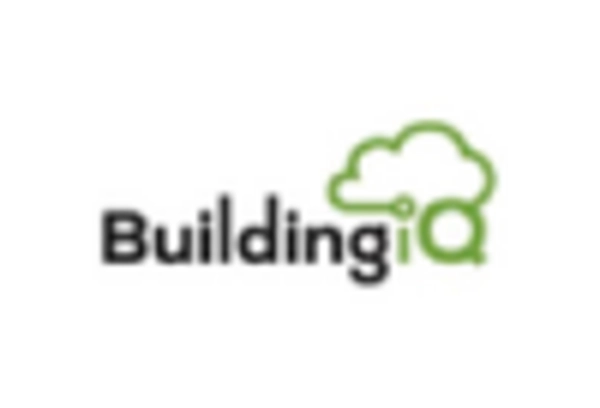Increased Focus on Sustainability
Sustainability has emerged as a crucial driver in the Building Analytic Market. Organizations are increasingly prioritizing sustainable practices, which necessitate the use of advanced analytics to monitor and reduce energy consumption. The global push towards net-zero buildings is prompting stakeholders to invest in building analytics solutions that provide insights into energy usage and waste management. Recent studies suggest that buildings equipped with analytics can reduce energy costs by up to 30%. This focus on sustainability not only aligns with corporate social responsibility goals but also enhances the marketability of properties. As a result, the Building Analytic Market is experiencing a surge in demand for solutions that facilitate sustainable building practices, thereby contributing to a greener future.
Growing Demand for Smart Buildings
The demand for smart buildings is a pivotal driver in the Building Analytic Market. As urbanization accelerates, there is a pressing need for buildings that are not only efficient but also capable of adapting to the needs of their occupants. Smart buildings leverage advanced analytics to optimize energy use, enhance occupant comfort, and improve overall operational efficiency. Market Research Future indicates that the smart building sector is expected to reach a valuation of over 500 billion dollars by 2026. This surge is attributed to the increasing integration of IoT devices and building management systems that utilize analytics to provide real-time insights. Consequently, the Building Analytic Market is poised for substantial growth as stakeholders recognize the value of data-driven decision-making in creating intelligent environments.
Regulatory Compliance and Standards
The Building Analytic Market is significantly influenced by the evolving landscape of regulatory compliance and standards. Governments and regulatory bodies are increasingly mandating the adoption of building analytics to ensure energy efficiency and sustainability. For instance, regulations aimed at reducing carbon emissions are compelling organizations to adopt advanced analytics solutions. The market for building analytics is expected to expand as companies strive to meet these compliance requirements. In 2025, it is anticipated that nearly 70% of new commercial buildings will be required to implement some form of building analytics to comply with local and international standards. This regulatory push not only drives demand for analytics solutions but also fosters innovation within the industry, as companies develop new technologies to meet compliance needs.
Integration of Artificial Intelligence
The integration of artificial intelligence (AI) technologies into the Building Analytic Market is transforming how data is processed and analyzed. AI algorithms can identify patterns and anomalies in building performance data, leading to more informed decision-making. According to recent estimates, the AI segment within the building analytics sector is projected to grow at a compound annual growth rate of over 30% through 2026. This growth is driven by the increasing demand for predictive maintenance and operational efficiency. As organizations seek to optimize their building management systems, the role of AI in automating data analysis and enhancing operational insights becomes increasingly critical. The Building Analytic Market is thus witnessing a paradigm shift, where AI not only enhances data interpretation but also contributes to sustainability goals by optimizing energy consumption.
Advancements in Data Visualization Tools
Advancements in data visualization tools are reshaping the Building Analytic Market by enabling stakeholders to interpret complex data more effectively. Enhanced visualization techniques allow for the simplification of intricate datasets, making it easier for decision-makers to grasp insights and trends. The proliferation of user-friendly dashboards and interactive reporting tools is facilitating a more intuitive understanding of building performance metrics. As organizations increasingly rely on data-driven strategies, the demand for sophisticated visualization tools is expected to rise. Market analysts project that the data visualization segment within building analytics will grow significantly, potentially doubling in size by 2027. This trend underscores the importance of clear communication of analytics findings, which is essential for driving actionable insights in the Building Analytic Market.


















Leave a Comment